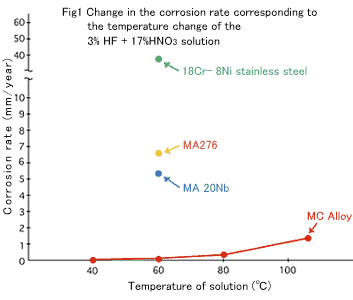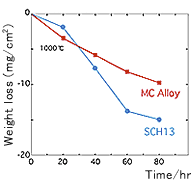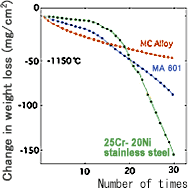MC Alloy
Ni-44Cr-1Mo (mass%)
Nickel chrome alloy featuring outstanding aspects both in corrosion resistance and heat resistance.
Aerospace & Energy Materials Dept.
Main Features
Proterial,Ltd. Okegawa Works has developed MC Alloy as nitric hydrofluoric acid-resistant material. This alloy is highly resistant to acid mixtures such as ones that contain hydrofluoric acids, sulfuric acids, phosphoric acids, and oxidizing acids. Also, it shows outstanding qualities as a heat-resistant material and shows superior resistance to oxidation and high-temperature corrosion (sulfur-attack-and vanadium-attack-resistant). MC Alloy is a unique and an innovative alloy which is a material that is resistant to both corrosion and heat.
Weldability
MC Alloy has the same weldability as austenite stainless steel, and it can be easily welded by a method that seals using inert gases such as TIG, MIG or plasma-arc. Since it has less hot water flow compared to stainless steel, the opening end should be wide.
Available Product Forms
Various shapes, such as flat-rolled plates, forgings, welding wires, wires, welded pipes and tubes, seamless pipes and tubes can be manufactured.
Specifications
Information on specifications to which MC Alloy can be ordered.
ASTM UNS N06044
| Plates | Bars, Forgings | Pipes and Tubes | Joints |
|---|---|---|---|
| B575 | B564 | B516 | B366 |
| B574 | B619 | ||
| B622 |
Corrosion Resistance on weld zone
Corrosion resistance to weld zone
As shown in the figure1, this alloy shows high corrosion resistance, as its corrosion rate to 3% hydrofluoric acid +17% nitric acid at 60°C is 1/1000 of stainless steel and 1/100 of MA276.
As shown in Table 2, MC Alloy has excellent corrosion resistance to 50% sulfuric acid at 80°C.

Table 1
Change in the corrosion rate
for the 3% HF+17%HNO3 solution at 60°C
| Alloy | Corrosion rate (mm/year) |
|---|---|
| MC Alloy | 0.042 |
| MA 20Nb | 5.15 |
| MA 276 | 6.5 |
| SUS 304 | 46.0 |
Table 2
Corrosion rate of each material
for 50% sulfuric acid at 80°C
| Alloy | Corrosion rate (mm/year) |
|---|---|
| MC Alloy | 0.004 |
| MA 22 | 0.41 |
| MA 625 | 1.3 |
Oxidation resistance of MC Alloy
Oxidation resistance of MC Alloy
Oxidizing tests were conducted every 20 hours repeatedly in the standard atmosphere. As a result, MC Alloy proved better oxidation resistance than SCH-13, as demonstrated in Figure 2. In addition, when the process of heating the alloy up to 1150°C for 24 hours in the standard atmosphere and then cooling it down to room temperature was repeated, MC alloy lost less weight than other alloys, as shown in Figure 3 which illustrates its superior qualities.
Fig.2 Reduction in quantity every 20 hours in 1000°C atmosphere.

Fig.3 Reduction in quantity every 24 hours in 1150°C atmosphere.

Simulation test of MC Alloy in low quality heavy oil combustion gas atmosphere (85% Na2SO4+15%NaCl)
Metal loss(mg/cm2)
| Retention temperature and time | MC Alloy | SCH-13 |
|---|---|---|
| 900°C X 20Hrs | 1.2 | 5.6 |
| 1,000°C X 20Hrs | 24.1 | 104.6 |
Sulfur-attack data of MC Alloy
Results of corrosion tests conducted in heavy oil heating furnace(950°C X 1year)
| Corrosion rate(mm/yr) | Wall thickness loss(mm) | |
|---|---|---|
| MC Alloy | 0.001 | 0.05 |
| MA 600 | 0.042 | 1.5 |
| SUS 310S | 0.152 | 0.52 |